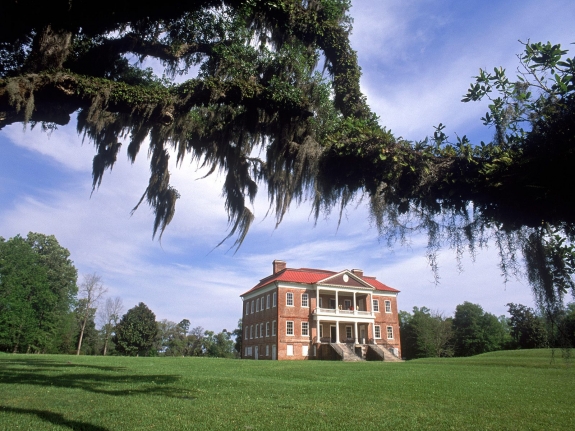
I recently visited Charleston, South Carolina. Coming from the chilly northeast, it was refreshing enjoying sunny days in the seventies. Add to that the palm trees, view of the harbor and Fort Sumpter, with the Atlantic Ocean beyond, and the elegant houses with verandas overlooking the streets or manicured back yards, and it seems a daydream.
In our upcoming Anniversary issue (Jan/Feb 2011) we will be featuring a number of Charleston’s jewels. The main reason for this is that Historic Charleston Foundation will be the loan exhibit at the 2011 Winter Antiques Show in Manhattan this January 21-30. In our current Autumn-Winter issue we started getting readers thinking about the loan show with an article on the history of the foundation by curator Brandy Culp (HCF was “founded in 1947 to preserve and protect the integrity of Charleston’s architectural, historical and cultural heritage.”). In the forthcoming Anniversary issue, her colleague Winslow Hastie will write about some of the many architectural preservation efforts within and outside of Charleston with which the foundation has been involved. Director Kitty Robinson will write about the loan show.
The flagship properties owned by Historic Charleston are the Nathaniel Russell House (1808), one of “America’s most important neoclassical dwellings,” and the Aiken-Rhett House (1818; 1830s; 1850s), “the most intact townhouse complex showcasing urban life in antebellum Charleston.” HCF was also integral in the early preservation efforts of Drayton Hall. Located outside of Charleston on the Ashley River, the plantation is now owned by the National Trust for Historic Preservation and “considered one of the finest examples of Georgian-Palladian architecture in the United States. The grounds represent one of the most significant, undisturbed historic landscapes in America.” An article on this spectacular house will be in the same Anniversary issue. Another important plantation located along the Ashley River is Middleton Place. Though the original mansion house was burned during the Civil War, the 1755 gentleman’s guest quarters serve as the museum, housing important furnishings and art. The Stableyards interpret eighteenth- and nineteenth-century life on a working plantation.
Middleton Place Foundation also owns the Edmonston-Alston House (1825; 1838) in downtown Charleston. While back in Charleston, visit the elegant Joseph Manigault House (1803), built with proceeds from the Rice industry in the early nineteenth century. The Heyward-Washington House (1772), also built from Rice profits, was originally owned by a signer of the Declaration, Thomas Heyward, Jr., and, opened in 1930 as “Charleston’s first historic house museum.” The house is fully furnished and contains some of the most noteworthy Charleston furniture to be found.
Both houses are owned by the Charleston Museum. Historic in its own right, the institution is referred to as “America’s First Museum, founded in 1773.” This institution showcases the “cultural and natural history of Charleston and the South Carolina Lowcountry.” While there are changing exhibits (such as the Sesquicentennial of the Civil War), the permanent installations include such “cabinets of curiosity” as prehistoric skeletons and extinct animals, “Early Days” (specimens, Egyptian relics, and other material from the museum’s early collecting history), weaponry from 1750 to the twentieth century, Civil War material, textile and silver galleries, regional materials, and hands-on exhibits for children. The museum is a veritable assemblage of interesting and well-interpreted material.
The Gibbes Museum of Art, founded with monies left by James Shoolbred Gibbes, was opened in 1905, with Gibbes’ direction for a building or hall for the purpose of the “exhibition of paintings.” The museum has expanded during the years, and today visitors can see both fine and decorative arts, “of Charleston, the Lowcountry and American South from the colonial era through today.”
There so much more to Charleston: more plantations; gardens; and naval and maritime museum, among other activities. Perhaps begin with a tour of the city, whether walking or in a carriage (by boat as well!). If you prefer a bus tour, that too is possible. Some tours also have themes such as art or ghosts. The rich culinary scene can be explored on culinary tours. There are plenty of tours with a focus on the rich history of the town as well, and, of course you can venture out on your own to see the sites. Along your way, be sure to visit the County Courthouse of 1753, “one of the most important buildings in the state.” Among the things you will see, are some of the original portions of the walled city of Charleston, located on the subterranean level.
Before you leave Charleston, be sure to visit the antiques dealers. Among them are Mary Helen McCoy Fine Antiques and Moore House American Antiques. Art galleries include Charleston Renaissance Gallery and The Sylvan Gallery.
When planning your trip, perhaps consider visiting this March. The weather is lovely that time of year, and from March 16-20, 2011, the Charleston Art & Antiques Forum offers attendees cutting edge scholarship. This year’s theme is “Made in America: Century by Century.” The timing overlaps with the March 18-20 Charleston International Antiques Show, a fundraiser for Historic Charleston Foundation, which brings us full circle to where we started this trip. Enjoy! There is a lot to see!



